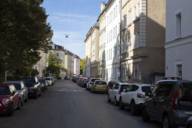
Parkstrasse is one of the liveliest streets in Schwanthalerhöhe neighbourhood. It is part of the Westend district which has been growing in popularity for years. Cool bars and Vietnamese restaurants are opening next to long-beloved landmark cafés like Marais.
If you go in search of a particular street in Schwanthalerhöhe, you will quickly notice that all the streets here are rather similar – in fact, even the locals get lost sometimes. What's more, every street in the area has so much on offer that it’s hard to single one out as special. But if we have to pick one, it's Parkstrasse, a street where gastronomy and retail meet in the best of ways. Additionally, the crossroads where it meets Schwanthalerstrasse is one of the liveliest spots in the neighbourhood Westend.
Sometimes, road junctions have this particularly inviting and inexplicable atmosphere, making them popular meeting places. This is also the case in Parkstraße.
Sometimes street intersections, corners and squares have a particularly inviting and inexplicable atmosphere, making them popular meeting places. This is also the case in Parkstraße, both at the intersection with Schwanthalerstraße and at the intersection with Gollierstraße. People meet here for a drink, a chat or a kebab – preferably at night, regardless of whether it's summer or winter. But Parkstraße is not only a popular meeting place, it also has a lot more to offer, as we discover this afternoon.
Our day begins at Marais, of course. There's hardly any other better-known café in Munich, even far beyond Schwanthalerhöhe. That's partly because the shop and café has persisted here in the fast-changing Westend district for some time now: it opened in 2006, so the Marais has accompanied quite a few locals through entire stages of their lives, as is evident in its clientele even now. Young people meet here to study; new parents cling desperately to their coffee cups; older men leaf through newspapers as they order lunch.
Marais is and remains timeless, and nothing – not even the huge clock face inside the café – can change that.
But it's not just the customer base and the staying power of the Marais that are special – the decor is also unique, as the shop and café inherited the 1920s inventory of the textile warehouse that was previously resident here. It seems that the café owners picked up a touch of the mercantile philosophy too, as these days you can buy almost anything you see at Marais. That includes not only the homemade cakes on the expansive counter, but also crockery, furniture, decorative items and even the selected pieces of vintage clothing hanging on the racks.
We opt for a late breakfast and are pleasantly surprised to find that the menu only features classics such as Swiss-style Bircher muesli and Strammer Max (a slice of fried bread with ham and egg) – visitors in search of trendy avocado toast or the almost-ubiquitous chia pudding will be disappointed. Marais stays true to what it is – that applies to the location and the breakfast menu, but also its trademark homemade cakes. Just add a coffee on the side and you're all set for a blissful afternoon and to completely lose track of time. Marais is and remains timeless, and nothing – not even the huge clock face inside the café – can change that.
Philipp Pander from the Pandapool creative agency also theorises that time passes a little differently in Westend: “I get the sense that people walk a little more slowly here than they do in other neighbourhoods.” He has been living on Parkstrasse for a year and a half, but has known Westend for much longer because he studied here over ten years ago. Much has changed in that time: “Back then you could barely find a place to get lunch, but now there are four Vietnamese restaurants on every street.” As an aside, that metric has actually become a pretty good barometer of the popularity of each respective Munich district. Philipp's favourite Vietnamese is Ca Go at Kazmairstrasse, just at the next corner.
Otherwise, he also likes meetings over cake at Marais: “It is so cosy to be sitting in there by the big windows when the weather is bad.” He also enjoys the occasional beer at Kilombo: “I've been coming here for years now so I always run into someone I know – but Kilombo is one of the few bars I would happily go to alone.” Philipp values the intimate atmosphere in the streets around Schwanthalerhöhe, that much-lauded “village in the city” feeling which every bit of Munich can claim to some extent. People seek out the small in the big – so you can go out in the city centre, just two U-Bahn stops away, but you don't have to.
Philipp values the intimate atmosphere in the streets around Schwanthalerhöhe, that much-lauded “village in the city” feeling. People seek out the small in the big – so you can go out in the city centre, but you don't have to.
But there's more to the special atmosphere in Westend, Philipp explains: “The district is diverse and very mixed, partly because of the high level of migration, but also because of the different age groups that come together here.” And although rents have risen in recent years and a lot has changed, Westend has kept its character. “There's always something happening here, and that can only have a positive effect.” Start-ups and labels are moving in, and urban shops and craft beer outlets are opening. That said, to suit those less enamoured of the new, there are also many long-established companies and shops here such as the Barry‘s Boazn (Parkstraße 25). With both neighbourhood pubs and Vietnamese eateries to be found, the slogan for this neighbourhood could be “between Boazns and Banh Mi”.